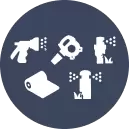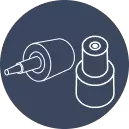A sprinkler system is a method of watering plants through spraying water in the air, similar to rainfall. It includes items like pipes, pumps, valves and sprinkler heads. Through these connective parts, it brings water from its source to the ground. Homes, farms and commercial properties water grass and plants with sprinklers.
Types of Sprinklers
There are different types of sprinklers designed for various spaces and needs. They all have their own applications and fit certain types of plants and landscapes.
1. Impact Sprinklers
Impact sprinklers shoot water in all directions with the help of a swinging arm. The arm strikes the stream of water, causing the head to rotate to distribute water more broadly. These sprinklers are sturdy and effective in big or lopsided spaces. They’re also popular on farms because they can accommodate high water pressure and rough outdoor conditions.
2. Spray Sprinklers
Spray sprinklers are stationary and spray water in a set pattern. They are ideal for small lawns, flower beds or anywhere with the same shape. These sprinklers disperse water evenly, and they work well in an area that needs water frequently.
3. Rotor Sprinklers
Rotor sprinklers rotate gradually while spraying water in multiple streams. They throw water farther than spray heads and are best for medium to large lawns. And they work more slowly, which gives time for the water to soak into the soil, making fewer puddles and dropping less water on the sidewalk.
4. Micro-Sprinklers and Bubblers
The micro-sprinklers are small and gentle. They provide a gentle spray that’s good for garden beds and young plants. Bubblers allow water to pour out just above the base of plants, making them ideal for deep watering trees and shrubs. Both are good for saving water and delivering the proper amount to plants’ roots.
5. Portable Sprinklers
The portable sprinklers are not embedded in the ground. They attach to a hose and can be repositioned as required. These are essentially simple, low-cost options for those who desire flexibility and easy watering without the complexity of installing an entire system.
Why Use a Sprinkler System?
There are numerous benefits of sprinkler systems for homeowners who desire to care for their lawns or gardens. They save time, water and help plants grow more robustly.
- Even Watering: Water is uniform across the area with sprinklers. This prevents dry and wet spots in the garden. Plants take what they need, and the soil remains healthy.
- Saves Time and Effort: Once set up, sprinklers can run on their own. Timers, perhaps with the assistance of smart controllers, allow people to schedule when, and for how long, they wish to turn on the water. This eliminates the chore of watering by hand.
- Conserves Water: Now, sprinkler systems are equipped with smart controls and sensors. These also allow for tweaking watering times according to the weather or how wet the soil is. That will allow them to use water only when it’s actually necessary.
- Supports Healthy Plants: Consistent, even watering strengthens roots and reduces stress on hot or dry days. A well-designed sprinkler system can lead to greener lawns and a healthier garden.
- Works for All Sizes: Sprinkler systems come in all shapes and sizes. Whether a small backyard or a large park, the system can be configured to suit the space and the kinds of plants.
Planning a Sprinkler System
To make a sprinkler system work well, it must be planned carefully. The layout should fit the earth, the plants, and the water source.
Zones and Sprinkler Placement
A yard or garden can be divided into “zones.” All zones have approximately equal water needs. For instance, a sunny lawn may need more water than a shady flower bed. If the sprinklers are in the right place, the water is making it everywhere evenly.
Water Pressure and Flow
Every sprinkler head requires a minimum pressure and flow rate to perform well. The water supply that is available should correspond to the system. The use of pressure regulators and flow control devices also helps keep things moving along optimally.
Soil Type Matters
Not all soils absorb water the same way. Sandy soil soaks it up immediately; clay holds the water and keeps draining late. The run times for sprinklers should be in line with the soil, so the water doesn’t run off or just lie there on the surface.
Landscape Shape
Hills or uneven ground will allow water to pool in low spots or to run down slopes. Selecting the proper sprinkler type, for example, slower rotors for slopes, can help address this and prevent water waste.
Setting Up the System
To work well, a sprinkler system needs to be installed properly. If everything is properly installed, it will all do its job.
Timers and Safety Devices
The system is automated by a controller or timer that activates and deactivates the system. Backflow preventers keep the water supply from getting contaminated. And both are critical elements toward a system that is safe and easy to manage.
Pipes and Trenches
The water is transported to the sprinkler heads through pipes. They get planted in the ground, so they have to be deep enough not to freeze or get damaged. The right type and size of pipe ensures the smooth flow of water.
Sprinkler Head Setup
Place each sprinkler head so it covers its section of the lawn without overlapping significantly. Heads need to reposition distance and direction. On slopes, check valves may be included to keep water from draining out of low sprinkler heads.
Seasonal Changes
In cold climates, systems must be drained or blown out with air before winter to prevent freeze damage. In the spring, the system should be checked to ensure everything is working after being turned off for the winter.
Final Thoughts
Sprinklers make irrigation easier, rapid and more effective. An efficient sprinkler system ensures a healthy lawn and garden and minimizes serious water wastage. From the simplest setup for a small yard to a full system for a larger property, there’s a sprinkler solution for every need. Smart irrigation can be accessible to anyone, with the right parts, planning and regular care.







